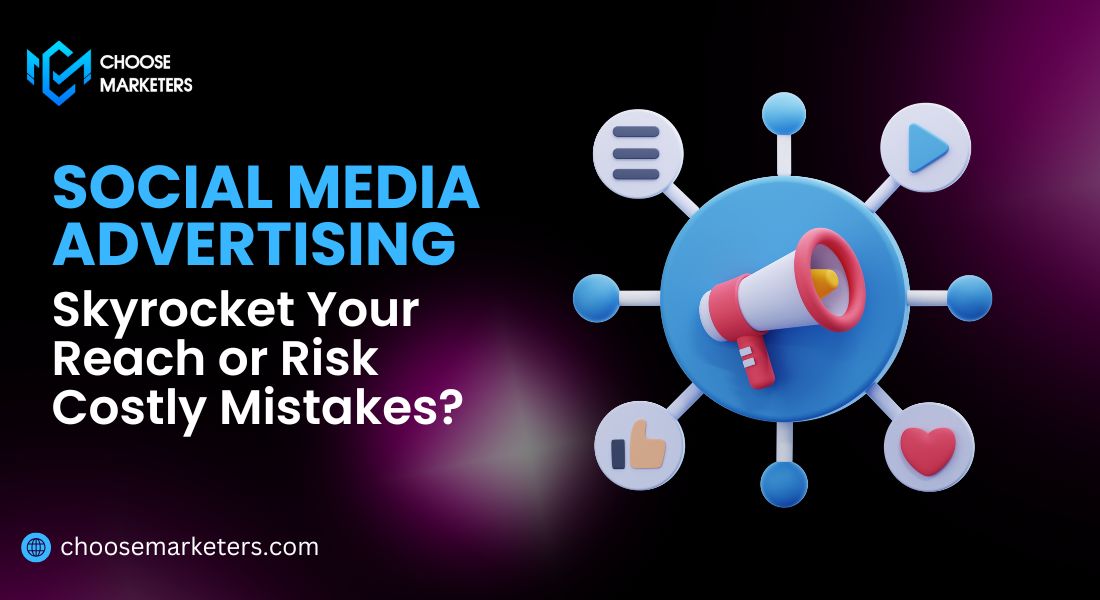

Social Media Advertising: Skyrocket Your Reach or Risk Costly Mistakes?
Social media advertising has become a cornerstone of digital marketing strategies, especially in the USA. With organic reach on the decline, businesses are increasingly turning to paid social media advertising to connect with their target audience, drive traffic, and achieve real business results. In this context, this guide will walk you through the essentials of social media advertising in 2024, including how much it costs, the best platforms, and the tools you need to optimize your ad campaigns.
Benefits of Social Media Advertising
Social media advertising offers numerous benefits for businesses looking to grow their brand and reach a larger audience. One of the primary advantages is the ability to target specific audiences based on demographics, behaviors, and interests. Social media advertising also provides real-time feedback, allowing businesses to monitor ad performance and make adjustments on the fly. Moreover, tracking ROI becomes easier with social media ads since platforms offer detailed analytics that show the financial impact of campaigns.
When compared to traditional forms of advertising, social media advertising is often more cost-effective, especially for small and medium-sized businesses. By investing in social media ads, brands can boost their visibility and create a steady stream of engagement across different platforms.
Social Media Marketing: The Key to Expanding Your Digital Presence
Social media marketing involves leveraging platforms like Facebook, Instagram, and LinkedIn to promote your brand, engage with your target audience, and drive business growth. With the right strategy in place, businesses can create tailored content, interact with followers, and use data-driven ads to boost brand awareness, generate leads, and increase sales conversions. As a result, in today’s digital landscape, social media marketing has become essential for building a loyal customer base and staying competitive.
Social Media Advertising Objectives
The objectives of social media advertising can vary based on your business goals. The most common objectives include:
- Brand Awareness: Increasing your brand’s visibility among potential customers.
- Traffic: Directing users to your website or app.
- Engagement: Encouraging likes, shares, and comments on your posts.
- Lead Generation: Capturing information from potential customers through forms.
- Sales Conversions: Driving purchases or sign-ups directly from the ad.
Each of these objectives can be achieved using different types of ads, depending on the platform and the ad format you choose.
Best Social Media Platforms for Advertising
Selecting the right platform for social media advertising is crucial. Here’s an overview of the most popular platforms in the USA:
- Facebook: Ideal for reaching a wide audience with a variety of ad formats, including photo, video, and carousel ads.
- Instagram: Great for visual content and reaching younger audiences. Instagram ads can be run through Meta Ads Manager.
- TikTok: Perfect for engaging short video content, TikTok ads reach a highly engaged audience.
- LinkedIn: Best for B2B advertising, particularly if you’re targeting professionals and businesses.
- Snapchat: Effective for targeting younger demographics through playful, visual ad formats.
- Twitter (X): Ideal for real-time engagement, with promoted tweets and takeover ads.
- YouTube: Excellent for video advertising, allowing brands to run skippable or unskippable ads before or during videos.
- Pinterest: A visual platform perfect for product promotion, particularly for e-commerce businesses.
Facebook Ads Breakdown
Facebook offers a range of ad formats and objectives for businesses. Popular formats include:
- Photo Ads: Single image ads with a link to your product or website.
- Video Ads: These can be short clips or longer videos that tell a story.
- Stories Ads: Full-screen, vertical video ads that appear between organic content.
- Carousel Ads: Allow you to showcase up to 10 images or videos in a single ad unit.
When it comes to costs, Facebook ads typically operate on either a cost-per-click (CPC) or cost-per-impression (CPM) basis. The average CPC ranges from $0.50 to $2.00, while CPM averages around $6 to $12, depending on your target audience and campaign type.
Instagram Ads Breakdown
Instagram ads are highly visual and work well for businesses in the fashion, beauty, and lifestyle industries. The most popular ad formats include:
- Reels Ads: Short-form video content that integrates seamlessly with user-generated content.
- Stories Ads: Full-screen vertical ads that capture attention quickly.
- Feed Ads: Traditional image or video ads that appear in the user’s Instagram feed.
- Carousel Ads: Multiple images or videos in a single post.
How Much Does It Cost to Advertise on Instagram?

Social media advertising, especially on platforms like Instagram, has become an essential tool for businesses looking to expand their reach and increase engagement. The cost to advertise on Instagram can vary depending on factors such as the target audience, ad format, and seasonality. Understanding these factors is crucial for any business looking to optimize its social media advertising strategy and budget effectively.
1. Instagram Advertising Pricing Models
When it comes to social media advertising on Instagram, two common pricing models are widely used: Cost Per Click (CPC) and Cost Per Thousand Impressions (CPM). With CPC, businesses only pay when someone clicks on their ad, which is ideal for driving traffic to a specific landing page. On the other hand, CPM charges for every 1,000 impressions, making it more suitable for increasing brand awareness.
For businesses engaging in social media advertising on Instagram, choosing between CPC and CPM depends on the campaign objectives. Both pricing models offer flexibility and can help meet specific business goals, such as traffic generation or brand exposure, by tailoring the social media advertising approach accordingly.
2. Average Cost to Advertise on Instagram
On average, Instagram’s cost per click (CPC) ranges between $0.70 and $1.00, depending on the target audience and industry. The cost per thousand impressions (CPM), on the other hand, typically falls between $5 and $10. These figures can fluctuate based on factors like competition, audience specificity, and timing, making social media advertising costs highly variable.
For example, businesses that use social media advertising to target a highly competitive market, such as fashion or fitness, may face higher CPC rates—up to $1.50. Similarly, during peak seasons like the holidays, Instagram’s advertising costs can rise as more brands compete for visibility in users’ feeds. Understanding these dynamics is essential when planning a social media advertising budget for Instagram.
3. Factors That Impact Instagram Ad Costs
Several factors influence how much it costs to engage in social media advertising on Instagram. The most important ones include ad placement, audience targeting, and ad format. Ads placed in Instagram’s feed tend to be more expensive than those in Stories or Reels, as feed ads typically have higher engagement rates. Additionally, the more specific your audience targeting—such as narrowing down age, location, and interests—the higher the cost per click.
The type of ad format also plays a role. For instance, video ads and carousel ads often cost more than standard image ads due to their interactive nature and potential for better engagement. Time of year can further influence Instagram advertising costs, with businesses competing more during peak periods, resulting in higher CPM and CPC rates. Tailoring your social media advertising strategy to account for these factors can optimize both costs and outcomes.
4. Cost Benchmarks by Objective on Instagram
The objectives behind your social media advertising campaign will also affect Instagram ad costs. For brand awareness campaigns, CPM rates typically range from $5 to $8, while campaigns aimed at driving traffic will see CPC rates averaging between $0.70 and $1.00. Lead generation campaigns, which require more interaction from users, often come at a higher price, with CPC ranging from $1.20 to $2.00.
For businesses focused on conversion campaigns, where the goal is to turn Instagram viewers into customers, the CPC can range from $1.50 to $3.00. Consequently, these higher costs reflect the additional targeting and engagement efforts required to convert users. Therefore, setting clear objectives for your social media advertising campaigns can help businesses manage costs and achieve specific goals more effectively.
5. Maximizing Your Instagram Ad Budget
To get the most out of your Instagram social media advertising budget, strategic planning is essential. One of the best ways to improve ad performance and reduce costs is through A/B testing. By testing different creatives, ad formats, and audience segments, you can optimize your social media advertising efforts and direct more of your budget toward the most effective ads.
Another effective method to reduce the cost of social media advertising on Instagram is retargeting. Retargeting allows you to show ads to users who have already visited your website or engaged with your content. Since these users are more likely to convert, retargeting helps improve ROI while minimizing the overall cost of your Instagram advertising campaigns.
6. Real-World Example: Instagram Advertising Costs
Let’s say a small e-commerce brand sets a $50 daily budget for a seven-day Instagram ad campaign. With a CPC of around $0.80, the brand could expect 62 clicks per day, resulting in about 434 clicks over the course of the campaign. This example highlights how social media advertising on Instagram can be scaled to fit various budgets while delivering measurable results.
In this scenario, the business’s total budget of $350 could generate significant traffic or conversions, depending on the campaign’s objective. Additionally, by tracking these metrics, businesses can assess the effectiveness of their social media advertising and, as a result, make data-driven decisions to improve future campaigns.
7. Comparing Instagram Ad Costs to Other Platforms
When compared to other social media advertising platforms like Facebook or TikTok, Instagram tends to have slightly higher costs, particularly for CPC campaigns. However, Instagram’s highly engaged audience often justifies the higher costs. For brands in industries like fashion, beauty, and lifestyle, Instagram’s visual nature makes it an ideal platform for social media advertising.
Despite the slightly higher cost, businesses investing in Instagram social media advertising often see higher engagement rates and better results due to the platform’s unique ability to connect with users through highly visual content. In the end, the increased investment can lead to stronger returns and more meaningful engagement.
8. Conclusion: Budgeting for Instagram Advertising
When planning how much to spend on Instagram, social media advertising costs depend on the specific campaign goals, audience targeting, and ad format. A general starting budget ranges from $300 to $1,000 per month, allowing businesses to test various strategies, track performance, and make adjustments. Moreover, by focusing on data-driven results and optimizing ads over time, businesses can maximize their ROI and, ultimately, ensure a positive return from their Instagram advertising efforts.
TikTok Ads Breakdown
TikTok is known for its highly engaging and entertaining video content. Ad formats on TikTok include:
- Spark Ads: These are boosted organic posts that can drive traffic or conversions.
- In-Feed Video Ads: Ads that appear as users scroll through their For You Page.
- Branded Hashtag Challenges: A popular option for driving engagement and user-generated content.
- TopView Ads: These ads appear immediately when the app is opened, ensuring maximum visibility.
TikTok ads typically operate on a CPM model, with an average CPM of around $10. This can fluctuate based on audience size, competition, and seasonality.
LinkedIn Ads Breakdown
LinkedIn is the go-to platform for B2B social media advertising. Popular ad formats include:
- Sponsored Content: Native ads that appear in users’ feeds.
- InMail Ads: Ads delivered directly to a user’s LinkedIn inbox.
- Carousel Ads: Multiple cards that showcase various products or services.
- Text Ads: Simple, short-form ads that appear on the right-hand rail of LinkedIn pages.
LinkedIn ads tend to be more expensive than other platforms, with CPC averaging around $5.00 to $8.00. However, the platform’s professional targeting capabilities make it worth the investment for B2B campaigns.
Snapchat Ads Breakdown
Snapchat offers a range of interactive ad formats that appeal to younger audiences. These include:
- Single Image/Video Ads: Basic ads that appear between user-generated content.
- Lenses AR Experiences: Interactive ads that allow users to engage with your brand through augmented reality.
- Story Ads: Full-screen ads that play sequentially like a story.
- Collection Ads: Showcase a range of products with tappable tiles.
Snapchat’s advertising costs are typically calculated on a CPM basis, with the average CPM ranging from $3 to $8, depending on targeting and engagement.
YouTube Ads Breakdown
YouTube is the world’s largest video platform, making it a prime place for video advertising. Ad formats include:
- In-Stream Ads: These are skippable ads that play before, during, or after other videos.
- Bumper Ads: Short, non-skippable ads that last up to 6 seconds.
- Masthead Ads: Large banner ads that appear at the top of the YouTube homepage.
- In-Feed Video Ads: Ads that appear in search results or next to related videos.
YouTube advertising costs vary, but the average CPC for YouTube ads is around $0.10 to $0.30. The average CPM is between $9 and $13.
Twitter (X) Ads Breakdown
Twitter, now rebranded as X, offers several ad formats, including:
- Promoted Tweets: These can include images, videos, or text-only ads.
- Trend Takeover Ads: Ads that appear at the top of the Explore tab, driving maximum visibility.
- Video Ads: Full-screen mobile ads with high engagement rates.
- Carousel Ads: Multiple images or videos in one tweet.
Ads of Twitter typically operate on a CPM model, with an average CPM of $6.00 to $10.00.
Pinterest Ads Breakdown
Pinterest is a great platform for e-commerce businesses looking to promote products visually. Popular ad formats include:
- Standard Pin Ads: Single image ads that blend seamlessly with organic content.
- Carousel Ads: Feature multiple images in a single ad.
- Shopping Ads: Directly promote products with a buy button.
- Video Ads: High-quality videos that capture attention.
Pinterest advertising costs are generally affordable, with CPC averaging between $0.10 and $1.50, and CPM rates around $2.00 to $5.00.
Tools for Social Media Advertising Management
To effectively manage your social media advertising campaigns, you’ll need the right tools. Here are some of the best tools available:
| Tool | Features | Pricing | Integrations |
| Hootsuite | Ad management, analytics, scheduling | Starting at $19/mo | Facebook, Instagram, LinkedIn, Twitter |
| Sprout Social | Social media management and analytics | Starting at $99/mo | Facebook, Twitter, Instagram |
| Buffer | Social media scheduling, analytics | Free and Paid Plans | Facebook, Instagram, LinkedIn, Twitter |
| Facebook Ads Manager | Manage and optimize Facebook and Instagram ads | Free | Facebook, Instagram |
| Google Analytics | Track website traffic and conversion data | Free | All platforms |
How Much Does It Cost to Advertise on Social Media?
The cost of social media advertising can vary based on a number of factors, including platform, audience targeting, and ad objectives. In general:
- Facebook and Instagram have an average CPC of $0.50 to $2.00.
- TikTok CPMs range from $8 to $15.
- LinkedIn tends to be more expensive, with CPCs ranging from $5.00 to $8.00.
- YouTube has lower CPCs, typically ranging from $0.10 to $0.30.
- Pinterest has affordable options with CPCs as low as $0.10.
Small businesses can expect to spend anywhere from $500 to $5,000 per month on social media advertising, depending on their goals and budget.
Case Studies of Successful Social Media Ad Campaigns
- PureGym’s Reels Campaign: By using organic-style Reels ads, PureGym saw a 5.6x increase in watch time and engagement. This highlights the effectiveness of aligning ad content with the platform’s native experience.
- NARS Cosmetics Instagram Shop Ads: NARS tested Instagram Shop checkout ads and saw a 6% increase in ROI, demonstrating the value of streamlining the customer purchase journey.
Tips to Maximize Social Media Ad Budget
To get the most out of your social media advertising budget, follow these tips:
- A/B Testing: Experiment with different ad creatives to see what resonates best with your audience.
- Leverage Organic Content: Promote high-performing organic posts to maximize engagement with minimal cost.
- Precise Targeting: Use demographic and behavioral targeting to ensure your ads are reaching the right audience.
- Monitor and Adjust: Continuously monitor ad performance and make adjustments to improve ROI.
Future Trends in Social Media Advertising
As we look ahead, several key trends are shaping the future of social media advertising:
- AI Integration: AI tools are being used to optimize ad targeting and improve campaign performance.
- Shoppable Ads: Social commerce is on the rise, with more platforms integrating shopping features directly into ads.
- Influencer Partnerships: Influencers continue to be a powerful force in social media advertising, particularly for product endorsements.
Social media advertising is an essential part of any business’s marketing strategy in 2024. By understanding the costs, platforms, and tools available, you can effectively reach your target audience and achieve your business goals. Whether you’re looking to boost brand awareness or drive direct sales, social media ads offer a versatile and cost-effective solution.

